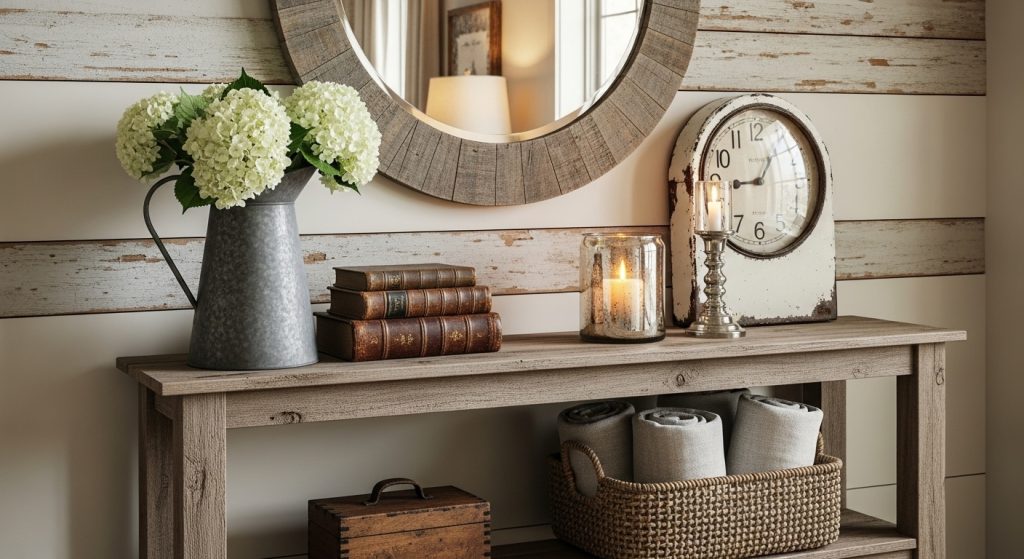Learning how to style a rustic console table with vintage decor is an exercise in telling a story. It is the art of curating a collection of objects that evoke a sense of history, warmth, and authentic character. This design approach transforms a simple entryway or hallway from a mere passageway into a meaningful and welcoming introduction to your home. It is about blending the rugged beauty of rustic materials with the unique soul of vintage finds. This creates a look that is not just decorated, but deeply personal and collected over time.

This definitive guide provides a professional framework for mastering this beloved style. We will move beyond simply placing old objects on a table. We will delve into the expert principles of curation, balance, and textural layering. These inspirational ideas and practical tips will give you the confidence to create a stunning, character-filled vignette. It will be a perfect reflection of vintage farmhouse charm.
What is the Core Principle of Styling a Rustic Console Table with Vintage Decor?
The core principle is to create a curated narrative of history and texture. It involves the intentional layering of authentic vintage finds with rustic, natural materials. This achieves a look that feels collected, warm, and intentional, rather than simply old or cluttered. It is about celebrating the beauty of imperfection and the stories that aged objects tell.
This design philosophy values authenticity above all else. It is the art of finding beauty in the weathered, the worn, and the well-loved. Unlike stark modernism, this style embraces a sense of nostalgia and comfort. It creates a space that feels grounded and deeply personal. The psychological appeal of vintage and antique items in creating a sense of history and stability is a powerful design tool. This approach is a cornerstone of creating timeless farmhouse rustic console inspiration.
How to Choose the Right Rustic Console Table as Your Canvas?
Choosing the right rustic Console table is the critical first step. The table itself is not just a surface; it is the foundational canvas for your entire display. It should be a piece with inherent character and a sense of history. Its material, finish, and form will set the authentic tone for all the vintage decor you place upon it.
What Materials Define a Rustic Console?
The materials should be natural, tactile, and appear aged or handcrafted.
- Reclaimed Wood: A table made from reclaimed wood, such as old barn wood, is the quintessential choice. It has a rich, natural patina, visible grain, knots, and saw marks that tell a story.
- Distressed Painted Wood: A solid wood table with a distressed or chippy paint finish, often in white or a muted color, provides a classic cottage or farmhouse feel.
- Solid, Chunky Wood: A console made from thick, solid planks of wood like pine, oak, or mango wood has a substantial, rustic presence that feels sturdy and timeless.
- Aged Metal Accents: Look for tables that incorporate elements of aged or blackened metal. This could be in the form of iron legs, corner brackets, or drawer hardware. This adds a touch of industrial farmhouse style.
What Design Features Should You Look For?
Beyond the material, certain design features are hallmarks of the rustic and farmhouse styles. Look for tables with simple, sturdy construction. Features like chunky, turned legs, X-brace details on the sides, or functional lower shelves for storage are all classic indicators of this aesthetic. The focus should be on craftsmanship and utility over ornate decoration.
How to Select the Perfect Vintage Anchor Piece?
The anchor is the large, character-rich item that is hung on the wall above the table. In a rustic and vintage scheme, the anchor is your most powerful storyteller. It sets the historical tone for the entire vignette. It should be a piece with a sense of age and a story to tell.
Why is an Aged, Wood-Framed Mirror an Ideal Anchor?
An aged, wood-framed mirror is an ideal anchor. It combines the space-enhancing properties of a mirror with the warmth and texture of rustic material. Look for a mirror with a frame made from reclaimed wood or one with a distressed, multi-layered paint finish. The patina on the frame and any slight imperfections in the mirror glass itself add to the authentic vintage charm. It reflects light while reinforcing the rustic theme.
How to Use Architectural Salvage Creatively?
Using a piece of architectural salvage as an anchor is a professional technique for creating a truly unique and authentic look. An old, multi-paned window frame, hung horizontally, is a classic choice. It creates a beautiful architectural focal point. Other creative ideas include:
- A section of a vintage pressed-tin ceiling panel.
- A small, weathered wooden gate or a section of a rustic fence.
- A large, antique clock face with a timeworn patina. These “found objects” have an inherent character that cannot be replicated with new items. They instantly add a layer of history to the space.
What Kind of Artworks Complement a Vintage Theme?
Artworks that complement a vintage theme often have a simple, pastoral, or nostalgic quality. Look for:
- Pastoral Landscapes: Oil or watercolor paintings of rolling hills, farms, or countryside scenes.
- Botanical Prints: Vintage-style prints of flowers, herbs, or trees.
- Simple Still-Life Paintings: Art depicting simple objects like fruit in a bowl or flowers in a vase. The frame is just as important as the art itself. A simple, aged wood frame or a distressed painted frame will complete the look.
How to Layer with Authentic Vintage Decor?
Layering is the process of thoughtfully arranging a curated collection of vintage objects on the tabletop. This is how to style a rustic console table with vintage decor to achieve a rich, collected-over-time feel. The key is to mix objects of different heights, scales, materials, and textures to create a visually interesting and cohesive display.
How Do Vintage Books Add Character and Height?
Vintage books are one of the most versatile styling tools for a rustic console. A horizontal stack of two or three old, cloth-bound books can be used as a pedestal. It can elevate a smaller object, giving it more presence. The aged, textural quality of the covers and the soft, warm tones of the pages add an immediate sense of history. Choose books for their beautiful, worn spines rather than their titles.
What is the Role of Vintage Stoneware and Pottery?
Vintage stoneware and pottery are essential for adding an earthy, handmade element. Old stoneware crocks, ironstone pitchers, or simple terracotta pots are perfect for this aesthetic. They can be used as vases for dried flowers or branches. They can also stand on their own as beautiful, sculptural objects. Their simple, utilitarian forms and matte, textural glazes are a hallmark of farmhouse style. The market for vintage pottery is a testament to its enduring appeal.
How to Incorporate Antique Metal Objects?
Incorporating antique metal objects adds a different material and a rich patina to your display. The cool, hard surface of metal provides a beautiful contrast to the warmth of the wood and the earthiness of the pottery. Look for items like:
- Old Balance Scales: A vintage kitchen or postal scale adds a charming, utilitarian touch.
- Galvanized Metal Buckets or Pitchers: These are perfect for holding branches or can be used as a rustic catch-all.
- Brass Candlesticks: A pair of aged brass candlesticks adds a touch of warm, metallic shine.
- Vintage Oil Lamps or Lanterns: These add a wonderful, nostalgic silhouette.
What About Vintage Glassware?
Vintage glassware can add a pop of subtle, aged color and a touch of sparkle to your rustic console. Look for old apothecary bottles in amber or green, a collection of antique blue mason jars, or a large glass demijohn. These can be left empty or can hold a single, simple stem. The light filtering through the colored, imperfect glass creates a beautiful, gentle effect.
How to Integrate Natural and Textural Elements?
Integrating natural and textural elements is crucial for achieving an authentic rustic feel. The farmhouse aesthetic is deeply connected to the natural world. These organic materials soften the display, add a layer of tactile interest, and reinforce the pastoral theme.
Why are Woven Baskets Essential for Storage and Texture?
Woven baskets are an essential element for both storage and texture. A pair of large wicker or seagrass baskets placed under the console table is the perfect place to store shoes, throw blankets, or other entryway essentials. They provide a massive dose of warm, natural texture. This beautifully balances the hard surfaces of the table and the vintage objects. Wire baskets, perhaps lined with a simple linen cloth, can also be used for a more industrial farmhouse look. The trend towards natural fibers in home decor is a significant one.
What are the Best Dried Florals and Branches for a Vintage Look?
For a vintage look, dried florals and branches are often more appropriate than fresh flowers. They have a preserved, timeless quality that complements the aged decor.
- Cotton Stems: The soft, white cotton bolls are a quintessential farmhouse element.
- Dried Lavender or Wheat Sheaves: These add a touch of the countryside and a subtle, natural scent.
- Pussy Willow or Curly Willow Branches: These provide dramatic, sculptural height with a simple, organic form.
- Dried Hydrangeas: Their muted, antique-like colors are perfect for a vintage palette.
How to Use Textiles for Softness and Layering?
Textiles can be used to add a final layer of softness and texture. A simple table runner made from a natural material like linen, burlap, or a vintage grain sack can be laid across the top of the console. This protects the wood surface. It also provides a soft foundation for the other decorative objects. This simple addition can make the entire vignette feel more finished and cohesive.
How to Achieve Balance and Avoid a “Cluttered” Look?
One of the biggest challenges of this style is knowing when to stop. The goal is a curated, collected look, not a cluttered, “antique store” look. This is achieved through the professional design principles of intentional curation, balanced asymmetry, and the use of negative space.
How to Apply the “Rule of Three” for Grouping Objects?
The “Rule of Three” is a classic design principle. It suggests that objects arranged in odd numbers are more visually appealing and dynamic than objects arranged in even numbers. When creating a small grouping on your console, try using three objects of varying heights. For example, a small vase, a framed photo, and a small decorative object. This will feel more natural and less staged than a simple pair.
Why is Varying Object Height So Important?
Varying the height of your objects is crucial for creating a dynamic and interesting display. You want to create a visual “skyline” with high, medium, and low points. This guides the eye across the arrangement and prevents it from feeling flat. A tall lamp on one side, a medium-height crock in the middle, and a low stack of books on the other side create a pleasing and balanced composition.
How to Use Negative Space to Let Objects “Breathe”?
Do not feel the need to fill every square inch of the console’s surface. Negative space, or the empty space around your objects, is a powerful tool. It gives each piece room to be seen and appreciated. It provides a visual pause for the eye. It is this empty space that prevents a collection of vintage items from feeling like clutter. Be intentional about leaving some areas of the tabletop bare.
How Can You Adapt This Style for Different Spaces and Budgets?
The rustic and vintage style is wonderfully adaptable. It can be tailored to fit a small, narrow hallway. It can also be achieved very affordably, as the style celebrates found objects and imperfections.
What Are Some Ideas for Narrow Hallways?
For a narrow hallway, the key is to choose a console table with a very shallow depth. The decor should then focus on verticality to draw the eye upward without taking up too much surface area. A tall, narrow mirror is a better choice than a wide one. A pair of tall, slender candlesticks might be a better choice for height than a bulky lamp. Our guide on cozy farmhouse console table ideas for narrow hallways provides more specific tips for these challenging spaces.
How to Achieve the Look on a Budget?
This is one of the most budget-friendly styles to achieve. Because it celebrates the aged and imperfect, secondhand finds are not just acceptable; they are preferred. Flea markets, thrift stores, and antique malls are the best sources for authentic vintage decor. A simple, inexpensive wooden console can be transformed into a rustic masterpiece with a bit of paint and some sandpaper. Our guide on budget-friendly farmhouse console makeovers is full of inspiring and affordable ideas.
What Are Some Simple DIY Projects for a Rustic Look?
The rustic aesthetic is perfect for DIY enthusiasts. An old wooden crate can be cleaned up and used as a tray. A set of old hardcover books can be bundled together with twine to create a decorative object. A simple sign can be painted on a piece of reclaimed wood. Our guide on DIY farmhouse console decor using reclaimed wood shows how simple, found materials can be transformed into beautiful and authentic decor.
Conclusion
The process of how to style a rustic console table with vintage decor is ultimately about creating a warm and personal welcome. It is about crafting a story of home and history in the very first space your guests see. By starting with a character-rich console table, choosing a powerful vintage anchor, and layering a curated collection of authentic, textural objects, you can create a stunning and meaningful focal point. This is more than just decoration; it is a celebration of the beauty of the imperfect, the lived-in, and the well-loved.











